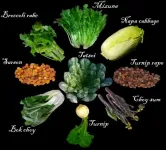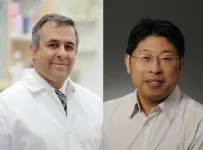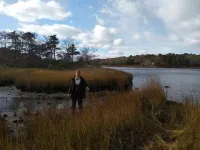(Press-News.org) Delicious to some, but a bitter bane to others' taste buds, vegetables like broccoli rabe, bok choy and turnips are a dinner staple ---and picky eater conflict --- around the world.
It all likely started in the mountains near present-day Afghanistan, where humans first domesticated turnips 3,500 to 6,000 years ago, according to a new study recently published in the journal Molecular Biology and Evolution. University of Wisconsin-Madison Professor of Botany Eve Emshwiller and her former graduate student Alex McAlvay (now an assistant curator assistant curator of economic botany at The New York Botanical Garden) led the research.
To identify the genetic root of it all, the research team reconstructed an evolutionary tree from a comparative DNA sequences analysis of more than 400 different varieties of the species Brassica rapa from around the world.
Just as varieties of ancient corn look very different than the hybrid crops of today's farms, Brassica revealed a similar past.
From this tree, they discovered that Central Asian turnips were the most genetically diverse crops. That in turn suggested that humans in the region may have valued most the fatter, starch-rich taproots that became turnips several thousand years ago, as agriculture took root around the world.
The research team identified both the Hindu Kush mountains as the epicenter of domestication, and weeds from the Caucasus region as among the most likely wild relatives of the species' vegetable crops. Turnips then spread west to Europe and east to East Asia, where farmers later selected for larger leaves. These leafy versions became bok choy, napa cabbage and broccoli rabe, among other vegetables found in today's grocery stores.
Interestingly, ancient cultures also pointed to evidence that matched the genetic analysis. Ancient literary references to turnips in the region, and the apparent existence of the word for "turnip" in the ancestor of languages from the region, also supported the turnip as the original domesticated form.
"It's important to know where your crops are from," said McAlvay. "In this work, we had a broader data set than had been used previously. And we also had more wild collections than had been used previously. Having enough of those non-cultivated forms allowed us to distinguish between those feral or escaped weeds and the ones that are likely truly wild."
Before the study, it remained unclear if turnips or oilseeds were the first tamed varieties.
This confusion has stemmed from the ubiquity of Brassica rapa and its many weedy forms, which could be truly wild or merely escaped crops turned feral. While wild and feral forms look similar, their genetic histories are vastly different.
"That parallel selection for leafy forms is interesting and gives us an evolutionary system to compare how this leafiness trait can arise," said McAlvay. Other farmers selected other lineages for their oil-rich seeds.
The true identities of these wild relatives -- which have been hidden for years because of the tangled web of family relationships in the species -- also provides valuable information to evolutionary biologists and crop breeders alike.
"We might want this information in order to conserve those wild relatives, so they don't disappear in the course of habitats being lost," said Emshwiller. Wild plants can confer valuable traits when crossed with crops, which typically lose their hardiness during domestication.
"And domestication is a good way to study evolution in general," Emshwiller adds. "If we understand how crops evolved under human influence, that can help us extrapolate to how wild plants might evolve under different kinds of selection."
For their next steps, the researchers want to include more weedy samples mainly from the original site of domestication, the Hindu Kush region. The region should be host to many different wild versions of Brassica rapa.
The study may also provide important information for this worldwide important crop and preserve important genetic resources to make brassica varieties more resilient as climate change and new pests may threaten some crops in the future.
INFORMATION:
HOUSTON-(June 3, 2021) - Results were released this week on a new treatment with the potential to improve the outcomes for patients with hereditary BRCA mutations and high-risk, early-stage breast cancer. These results represent the first time a drug that blocks cancer cells from repairing their DNA (called a PARP inhibitor) has been shown to significantly reduce the risk of breast cancer returning in high-risk patients following completion of standard chemotherapy, surgery and radiation therapy.
Titled "Adjuvant Olaparib for Patients with BRCA1 or BRCA2 Mutated Breast Cancer," the paper appears in the June 3 issue of the ...
Could an over-the-counter health "shot" help fight COVID-19? George Mason University researchers think it just might. ...
ROCHESTER, Minn. -- A study by Mayo Clinic researchers provides some clarity in the use of direct oral anticoagulants (DOAC), such as apixaban and rivaroxaban, to treat acute venous thromboembolism (VTE) in patients with gastrointestinal cancers. The findings were published Wednesday, June 2, in Mayo Clinic Proceedings.
Among the study's findings:
Rivaroxaban showed no higher risk of bleeding in luminal gastrointestinal cancer and should not be considered contraindicated in this group of patients.
Apixaban showed a higher risk of bleeding in patients with luminal gastrointestinal cancer, and it should be used with great caution to treat this type of cancer until more studies ...
WOODS HOLE, Mass. -- Plastics are everywhere. From cell phones to pens and cars to medical devices, the modern world is full of plastic-- and plastic waste. New research from scientists at the Marine Biological Laboratory (MBL) END ...
A team led by UC Riverside engineers has developed a catalyst to remove a dangerous chemical from water on Earth that could also make Martian soil safer for agriculture and help produce oxygen for human Mars explorers.
Perchlorate, a negative ion consisting of one chlorine atom bonded to four oxygen atoms, occurs naturally in some soils on Earth, and is especially abundant in Martian soil. As a powerful oxidizer, perchlorate is also manufactured and used in solid rocket fuel, fireworks, munitions, airbag initiators for vehicles, matches and signal flares. It is a byproduct in some disinfectants ...
Fukuoka, Japan - The global threat of ongoing climate change has one principal cause: carbon that was buried underground in the form of fossil fuels is being removed and released into the atmosphere in the form of carbon dioxide (CO2). One promising approach to addressing this problem is carbon capture and storage: using technology to take CO2 out of the atmosphere to return it underground.
In a new study published in Greenhouse Gases Science and Technology, researchers from Kyushu University and the National Institute of Advanced Industrial Science and Technology, Japan, investigated geological storage of low-purity CO2 mixed with nitrogen (N2) and oxygen (O2), produced by direct air capture (DAC) using membrane-based technology.
Many current ...
Climate scientists at the Nanyang Technological University, Singapore (NTU, Singapore) have extended the known record of Singapore's sea-level to almost 10,000 years ago, providing a more robust dataset to aid future predictions of sea-level rise.
One of the main challenges in researching climate change is to reconstruct its history over thousands of years. To have a better sense of the potential causes and effects of future changes, scientists need to learn from and understand the past.
Extracting ancient sediments from a depth of up to 40 m underground at a site at Singapore's Marina South, an international team led by NTU researchers put the samples through rigorous laboratory ...
Bottom Line: The majority of surveyed Americans had an inadequate understanding of palliative care, and frequency of health care utilization was one determinant of knowledge.
Journal in Which the Study was Published: Cancer Epidemiology, Biomarkers & Prevention, a journal of the American Association for Cancer Research
Author: Motolani Ogunsanya, PhD, an assistant professor at The University of Oklahoma Health Sciences Center
Background: Palliative care aims to improve the quality of life for patients and caretakers by addressing the physical, psychological, and logistical challenges associated with a disease or its treatment. In contrast to hospice, which provides comfort care for patients who have stopped treatment and are near the end of life, palliative care serves as an ...
Oncotarget published "Characterization of the inflammatory microenvironment and hepatic macrophage subsets in experimental hepatocellular carcinoma models" which reported that HCC typically develops on a background of chronic inflammation and fibrosis with tumor associated macrophages playing an important role in chronic inflammation-induced HCC and progression.
However, the liver harbors unique macrophages, resident liver Kupffer cells and monocyte-derived macrophages, and their contribution to HCC and to the population of TAMs is incompletely known.
Here, the authors characterized the tumor microenvironment and the proportion and transcriptional profile of ...
A growing number of people use they/them pronouns to signal their gender identity, but for many people, use of "they" to refer to a single individual takes some getting used to.
Results of a recent END ...






